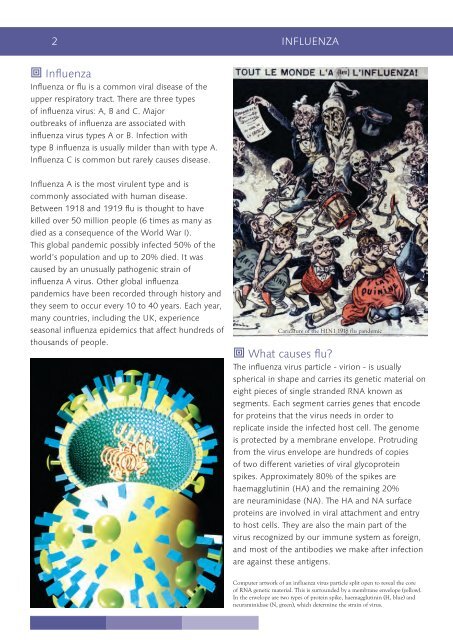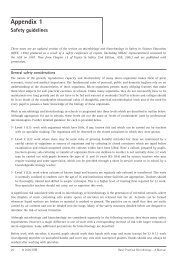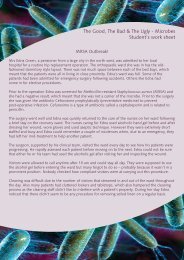INFLUENZA - Microbiology Online
INFLUENZA - Microbiology Online
INFLUENZA - Microbiology Online
You also want an ePaper? Increase the reach of your titles
YUMPU automatically turns print PDFs into web optimized ePapers that Google loves.
2 <strong>INFLUENZA</strong><br />
Influenza<br />
Influenza or flu is a common viral disease of the<br />
upper respiratory tract. There are three types<br />
of influenza virus: A, B and C. Major<br />
outbreaks of influenza are associated with<br />
influenza virus types A or B. Infection with<br />
type B influenza is usually milder than with type A.<br />
Influenza C is common but rarely causes disease.<br />
Influenza A is the most virulent type and is<br />
commonly associated with human disease.<br />
Between 1918 and 1919 flu is thought to have<br />
killed over 50 million people (6 times as many as<br />
died as a consequence of the World War I).<br />
This global pandemic possibly infected 50% of the<br />
world’s population and up to 20% died. It was<br />
caused by an unusually pathogenic strain of<br />
influenza A virus. Other global influenza<br />
pandemics have been recorded through history and<br />
they seem to occur every 10 to 40 years. Each year,<br />
many countries, including the UK, experience<br />
seasonal influenza epidemics that affect hundreds of<br />
thousands of people.<br />
Caricature of the H1N1 1918 flu pandemic<br />
What causes flu?<br />
The influenza virus particle - virion - is usually<br />
spherical in shape and carries its genetic material on<br />
eight pieces of single stranded RNA known as<br />
segments. Each segment carries genes that encode<br />
for proteins that the virus needs in order to<br />
replicate inside the infected host cell. The genome<br />
is protected by a membrane envelope. Protruding<br />
from the virus envelope are hundreds of copies<br />
of two different varieties of viral glycoprotein<br />
spikes. Approximately 80% of the spikes are<br />
haemagglutinin (HA) and the remaining 20%<br />
are neuraminidase (NA). The HA and NA surface<br />
proteins are involved in viral attachment and entry<br />
to host cells. They are also the main part of the<br />
virus recognized by our immune system as foreign,<br />
and most of the antibodies we make after infection<br />
are against these antigens.<br />
Computer artwork of an influenza virus particle split open to reveal the core<br />
of RNA genetic material. This is surrounded by a membrane envelope (yellow).<br />
In the envelope are two types of protein spike, haemagglutinin (H, blue) and<br />
neuraminidase (N, green), which determine the strain of virus.









